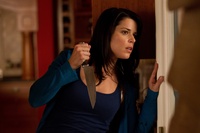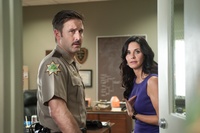'Scream' movies endure because they're so much more than horror

Neve Campbell stars in "Scream 4," opening April 15.
If the Ghostface killer of Wes Craven’s “Scream” series asked me his trademark question, “Do you like scary movies?” my answer would be a big, fat, presumably disappointing “No.” For I’ve never enjoyed horror films.
But even I, with my long-established “movie coward” credentials, make an exception regarding the “Scream” movies and anxiously await the April 15 release of the newest installment, “Scream 4,” shot last summer in Ann Arbor and neighboring areas.
Why do “Scream” movies make the — ahem — cut for me? They’re certainly horror movies in their own right, chock full of genre conventions I otherwise can’t/won’t stomach: ruthless, anonymous serial killers (as one character says in the first film, “It’s the millennium. Motives are incidental.”); gruesome, watch-through-your-fingers violence; and bucket-loads of blood and gore.
As a point of proof, check out the opening 12-minute section of the first “Scream” (1996), which, yes, contains profanity and violence, but is also memorable, suspenseful, and undeniably engrossing. (And using the ballooning Jiffypop as a visual representation of the scene’s rising tension is, I would argue, a small stroke of genius.)
Yet while the series features these traditional horror elements, the “Scream” movies also employ an irresistible “whodunit” structure, inviting the audience to join the on-screen characters in putting together the story’s pieces in order to solve the mystery regarding the killer’s identity. And although we do so from the seemingly safe position of our theater seats or a couch, original screenwriter Kevin Williamson takes great pains to plant doomed victims in both places, lest we feel too smugly removed from it all.
Case in point, Jada Pinkett Smith suffers a bloody death while watching a movie near the start of “Scream 2” (1997). Here’s the scene (again, viewers should be warned that the clip contains adult language and violence).
The series also gleefully embraces a cheeky, postmodern stance — openly discussing, dissecting, and questioning the genre’s “rules” while mocking them in cleverly funny ways. (Because the first film claims that young people who have sex in horror movies are consistently punished, a surviving character remarks, “I never thought I’d be so happy to be a virgin.”) And since the series made an effort to both subvert and reinforce these rules at different times, viewers never quite knew what was coming next.
But the “Scream” series’ humor — which was the initial selling point for me — succeeds precisely because it often flatters and, let’s be frank, congratulates the contemporary pop culture junkie by letting you feel like you are in on the jokes.
Yes, some subtle horror movie shout-outs probably blew right past me; but I nonetheless got to feel temporarily "hip" and included because I, along with other mainstream moviegoers, would catch references about Ricki Lake, “Clueless,” Tori Spelling (who proved to have a sense of humor about her own image by appearing in “Scream 2”), “Saved by the Bell,” “Showgirls,” and Jennifer Aniston (“Scream”’s Gale Weathers, played by “Friends” star Courteney Cox, explains that nude online photos of herself consisted of her head pasted on to Aniston’s body), among countless others.
The references clearly targeted a young movie crowd that considered themselves culturally plugged in, and caused fans to feel a sense of ownership toward the series. This seems key to the role that “Scream” played in powerfully reviving the horror genre (and inspiring copycats, not surprisingly) in the ‘90s — a time that many slasher film enthusiasts view as a nadir — by drawing, well, new blood to the multiplex.
But it’s also important to note that in addition to “Scream”’s wiseacre jokes, and despite the violence and gore that are inevitably a part of the films, there is a sweetness — a kind of beating heart — underlying it all. The series' heroine, Sidney Prescott (Neve Campbell), is fragile and strong simultaneously, damaged from the start by the brutal, baffling murder of her mother. She’s trapped in a nightmarish situation from which she'll never escape, but her wits and her will consistently see her through, and we root for her every step of the way.

David Arquette and Courteney Cox reprise their roles as Dewey and Gale in "Scream 4."
Yes, Dewey gets lots of laughs, but they’re never mean-spirited. For rather than making fun of him outright, the “Scream” series holds Dewey up as an impossibly genuine, earnest man who happens to live in cynical times. (In “Scream 2,” Dewey asks television reporter Gale Weathers, played by Cox, “How do you know that my dimwitted inexperience isn't merely a subtle form of manipulation, used to lower people's expectations, thereby enhancing my ability to effectively manuever within any given situation?” Because you could never be that calculating, my dear Dewey.)
The character is so beloved by fans, in fact, that one of my lasting memories of watching the "Scream" films in the theater involved a moment when the audience was made to think that their favorite cop had been killed. When Arquette suddenly re-appeared on the screen, injured but alive, the movie theater crowd spontaneously, happily cried out, "Dewey!"
And the unlikely romance that develops between good-guy Dewey and ruthless, selfish, fame-seeking Gale embodies, in a nutshell, the core appeal of the “Scream” series. Just as Dewey aims to marry his opposite at the end of "Scream 3" (2000), the “Scream” films unabashedly combined seemingly incongruous film genres, pairing grisly horror with humor and heart, plus a dash of romantic comedy. (See Dewey’s simple, endearing proposal in the clip below.)
The result is a self-aware, charming mash-up that not only breathed life into an ailing movie genre (the series has earned over $500 million worldwide), but also turned a certain scaredy-cat contingency into lifelong "Scream" fans.
So bring on Ghostface, and let the legitimately scary, but also tongue-in-cheek, fun begin all over again.
Jenn McKee is the entertainment digital journalist for AnnArbor.com. Reach her at jennmckee@annarbor.com or 734-623-2546, and follow her on Twitter @jennmckee.


Comments
Spooner
Sun, Apr 10, 2011 : 3:35 p.m.
For me, Scream 4 meant the sale of 4 hats to David Arquette. A stocking cap for David, a fedora for Neve, and 2 other hats for David's friends. VERY SCARY!